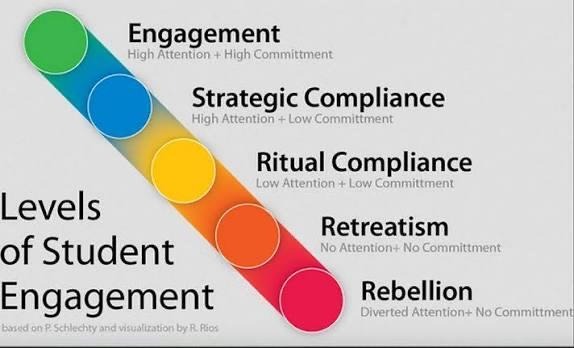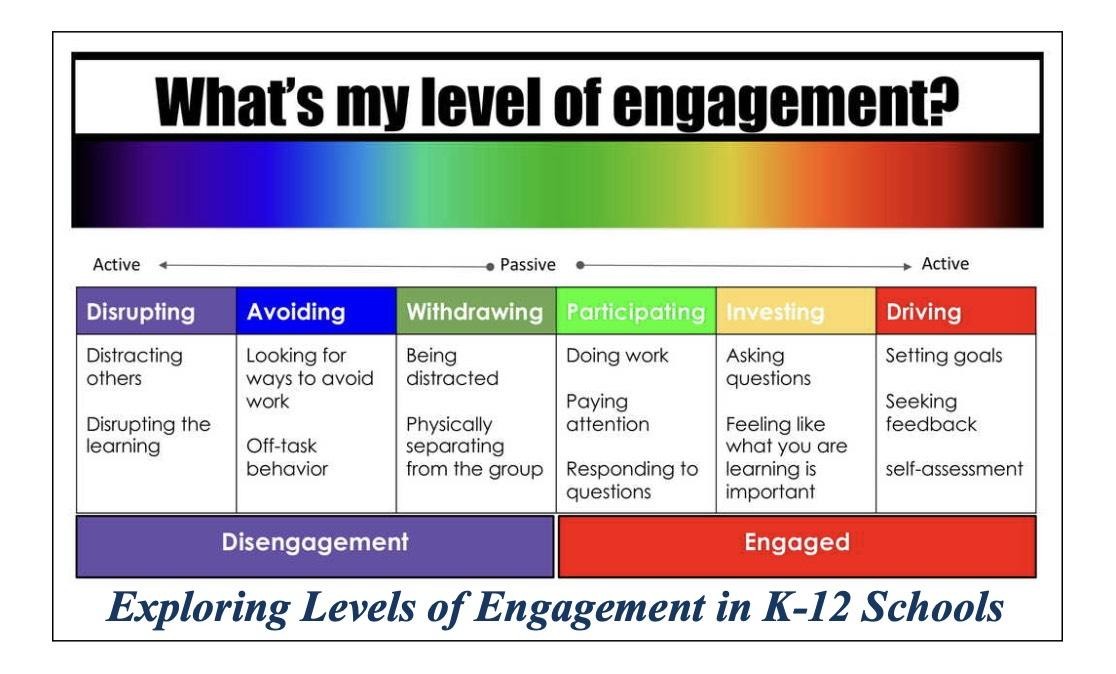"Good feedback works to its own redundancy.” - Dylan Williams
Unfortunately, some of the most recent initiatives in education designed to improve teachers’ practices in the classroom, have been reduced to a checklist of attributes in the formal evaluation process.
This is because we failed to draw the distinction between evaluating educational professionals and improving instructional practices of the same. The former is a compliance piece. A “must do” to meet the requirements of policies and other employee-employer agreements. This is an annual “check off the boxes to remain employed” process for teachers. The annual evaluation process is arguably, incompatible with a more meaningful, continuous and effective instrumental improvement partnership.
So as you read further, put the clinical classroom observation for evaluation aside for the moment. Also, put your struggling teachers aside as well. They need and deserve a dedicated, differentiated plan of support; such is beyond the scope of this discussion. Think of the Dimensions of Effective Feedback to Teachers as either: 1) in addition to that process or even better, or 2) in lieu of that process for the mass of your teachers; those in year 2 through 35 of teaching who are proficient to master teachers.
.png)
“Themed Classroom Strolls” with Feedback
Themed Classroom Strolls with Feedback is a variation of more vague systems of classroom visits such as Instructional Rounds and Learning Walks. Specifically, it differs in its formality and immediate need to draw conclusions and solutions. “Strolls” are more of a partnership with shared evidence relying on professionalism and commitment to initiate changes to improve classroom instructional practices. Yup, more organic than strategic. Strolls are centered on relationship building and a common understanding of what is going on in the classroom. No SMART Goals here.
“Themed”
Select a “Theme” for the Classroom Strolls over a period of time - a month, a marking period, semester or year. It can be a collaborative selection or a top-down decision.
A theme is essentially a focus on a particular instructional strategy/classroom component. The list of themes is endless; some high impact themes would be:
- Type of Questioning
- Classroom Environment
- Formative Assessment
- Student Engagement
- Student Grouping
- Classroom Management
- Cultural Responsiveness
- Technology Integration
- Research-based Instructional Strategies
- First 10 minutes of class
- Last 10 minutes of class
“Classroom Strolls”
The classroom stroll is an unplanned unannounced classroom visit, which will gather data on the agreed-upon theme. It’s also untimed. The visit could be as little as five minutes to a more substantial 15 to 20 minutes. The individual doing the strolling could be a principal, administrator, supervisor of curriculum, or even another teacher or colleague. The stroller becomes a participant observer in the class, not only watching and gathering data, but also interacting with students and the teacher, if all are comfortable with such. This is in sharp contrast to other similar feedback models where the visitors are supposed to be invisible.
School Leaders can pretty easily stroll into classes 2 to 3 times a day if the visits are coupled with the passing of classes; accomplishing both the classroom stroll and hallway supervision with the same walk.
“With Feedback”
Let’s put the idea of “How” the feedback gets back to teachers–whether it be an email, handwritten note, GoogleDoc or some type of fancy application–on the bench for the purposes of this discussion. Efficient ways to get feedback to teachers is best left to the individual school. Regardless of the delivery vehicle, the important thing is to make certain the feedback is prompt, if not immediate. The first time the teacher looks for the feedback, it should be there.
Instead of “How” the feedback gets to the teacher, let’s focus on what the feedback is as compared to what it is not. Feedback is raw data. Feedback is observations without comments. Feedback is tally marks, amounts of time, etc. without analysis. Feedback is exact quotes from the classroom.
Feedback is often confused with guidance. Guidance has its place, but not in daily Themed Classroom Strolls. Guidance, interpreting data, giving suggestions and drawing conclusions may come at the end of your themed classroom stroll period of time. Guidance and suggestions come only when obvious patterns emerge in the feedback and the data is clear to all involved, this facilitates consensus on actionable steps for improvement.
So when it comes to the feedback from themed classroom strolls, think of it more like the results of your blood work. You get the raw data. Whether the data is good, bad or insignificant is a discussion for a different time. The raw data may be individually significant and/or collectively significant.
Now, back to the “theme”. For data to be useful, it has to be valid. Data Validity is something very specific. Validity means that it measures what it’s supposed to measure. Additionally, for data to be useful, it has to be reliable. Data reliability is also something very specific. Reliability means that if a different observer saw exactly the same classroom snippet, the second observer would produce the same data as the first observer. Reliability is when both observers see an animal, and both identify the animal as a bear. Validity is when the animal identified is actually a bear; not a duck…
For themed classroom strolls to achieve both data reliability and validity, there needs to be an agreed-upon system of measurement, scale, or set of indicators that addresses the theme. Ideally, teachers and administrators have received professional development on this agreed-upon system of measurement thereby developing a common language for discussing the theme.
Suppose student engagement was the theme of this marking period for your classroom strolls. Here are two potential systems of measurement to guide the data collection and feedback. Both the teacher and stroller should understand the indicators associated with each category of engagement and be able to place students in each of the designated categories.
During the classroom visit, the stroller simply uses the indicators to evaluate which category each of the students fall, making tallies in the appropriate category. The feedback to the teacher is simply the stroller’s data about the number of students in each of the categories of student engagement at that particular time in the classroom visit.


The single feedback is probably insignificant. However, cumulatively, the feedback from a number of visits may indicate a pattern of student engagement for the individual teachers. Moreover, collective feedback from multiple teachers over a longer period of time may also indicate a pattern in student engagement in need of attention in the school.
Another popular theme for classroom strolls is Level of Questioning. We are all familiar with Dr. Bloom’s hierarchy. Again for the moment, let’s put Bloom aside because, arguably, there’s too many levels for our classroom strolls to be reliable. We don’t need to be arguing between whether it’s level four or level five in the Bloom hierarchy. Costa’s Level of Questioning essentially does the same thing, but lumps questioning into three broader categories of Gathering, Processing and Applying. This is a better fit for the more informal theme of a classroom stroll.

Again during the visit, the stroller simply attributes each of the teacher’s questions to one of the three categories in the measuring system. (This can also be done with students’ questions.) The feedback to the teacher is simply totals in each of the three categories of questioning during the time the stroller was in the classroom.
Individually, this singular classroom visit and tallies probably doesn’t have a lot of meaning as we’re not sure what the learning target was for this particular lesson and the depth of questioning necessary to achieve it. Only additional strolls and time will tell if significant patterns exist.
The Magic of Collective Discovery and Understanding and the Power of Professionalism
This is where things become more meaningful. Over time, the collective group better understands the particular system of measurement. Essentially, causing intrinsic, self-imposed professional learning and reflection on one’s classroom practice. Simply identifying the theme and measurement system will cause a certain level of organic instructional improvement. Voluntary discussions among staff begin, creating informal “Pop-Up PLCs” driving incremental change in classroom practices.
Moreover, when patterns develop over time either in a particular teacher’s classroom practices or the school as a whole, the data will be accepted without dispute. For example, suppose the compilation of data from your team’s classroom strolls on questioning over multiple strollers and many, many different classrooms shows a significant majority of questions in the lower level of “Gathering” with only a few outliers in the highest levels. This should cause the posing of additional questions about curriculum, depth of knowledge and scaffolding you and your staff may want to address.
The same idea applies to the data for an individual teacher. Suppose the same pattern of questioning is evident over time over multiple observers, over multiple lessons.
But here’s the best part, by simply providing feedback and the raw data without judgment and suggestions, there’s a good chance your teachers, as professionals, will see their own patterns and shortcomings and strive to make adjustments in that area without intervention from a supervisor.
The Power of Professionalism, Raw Data and Common Understandings!
We leave you with the following essential questions:
- What systems do you have in place for common language, understanding and measurement of classroom instructional practices?
- Are you unconsciously mixing feedback with guidance, observations with suggestions? Data with data interpretation?
- Are you using the annual teacher evaluation system concurrently as your system of classroom instructional improvement?







